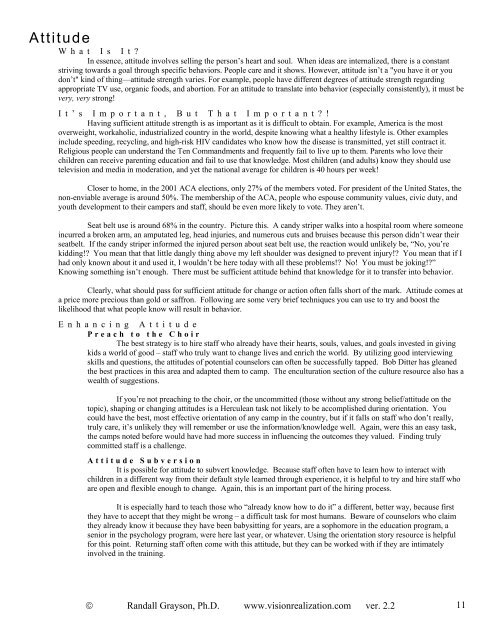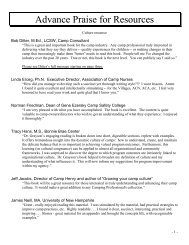Taking Camp Staff Training From Good To Best ... - Vision Realization
Taking Camp Staff Training From Good To Best ... - Vision Realization
Taking Camp Staff Training From Good To Best ... - Vision Realization
You also want an ePaper? Increase the reach of your titles
YUMPU automatically turns print PDFs into web optimized ePapers that Google loves.
Attitude<br />
What Is It?<br />
In essence, attitude involves selling the person’s heart and soul. When ideas are internalized, there is a constant<br />
striving towards a goal through specific behaviors. People care and it shows. However, attitude isn’t a "you have it or you<br />
don’t" kind of thing—attitude strength varies. For example, people have different degrees of attitude strength regarding<br />
appropriate TV use, organic foods, and abortion. For an attitude to translate into behavior (especially consistently), it must be<br />
very, very strong!<br />
It’s Important, But That Important?!<br />
Having sufficient attitude strength is as important as it is difficult to obtain. For example, America is the most<br />
overweight, workaholic, industrialized country in the world, despite knowing what a healthy lifestyle is. Other examples<br />
include speeding, recycling, and high-risk HIV candidates who know how the disease is transmitted, yet still contract it.<br />
Religious people can understand the Ten Commandments and frequently fail to live up to them. Parents who love their<br />
children can receive parenting education and fail to use that knowledge. Most children (and adults) know they should use<br />
television and media in moderation, and yet the national average for children is 40 hours per week!<br />
Closer to home, in the 2001 ACA elections, only 27% of the members voted. For president of the United States, the<br />
non-enviable average is around 50%. The membership of the ACA, people who espouse community values, civic duty, and<br />
youth development to their campers and staff, should be even more likely to vote. They aren’t.<br />
Seat belt use is around 68% in the country. Picture this. A candy striper walks into a hospital room where someone<br />
incurred a broken arm, an amputated leg, head injuries, and numerous cuts and bruises because this person didn’t wear their<br />
seatbelt. If the candy striper informed the injured person about seat belt use, the reaction would unlikely be, “No, you’re<br />
kidding!? You mean that that little dangly thing above my left shoulder was designed to prevent injury!? You mean that if I<br />
had only known about it and used it, I wouldn’t be here today with all these problems!? No! You must be joking!?”<br />
Knowing something isn’t enough. There must be sufficient attitude behind that knowledge for it to transfer into behavior.<br />
Clearly, what should pass for sufficient attitude for change or action often falls short of the mark. Attitude comes at<br />
a price more precious than gold or saffron. Following are some very brief techniques you can use to try and boost the<br />
likelihood that what people know will result in behavior.<br />
Enhancing Attitude<br />
Preach to the Choir<br />
The best strategy is to hire staff who already have their hearts, souls, values, and goals invested in giving<br />
kids a world of good – staff who truly want to change lives and enrich the world. By utilizing good interviewing<br />
skills and questions, the attitudes of potential counselors can often be successfully tapped. Bob Ditter has gleaned<br />
the best practices in this area and adapted them to camp. The enculturation section of the culture resource also has a<br />
wealth of suggestions.<br />
If you’re not preaching to the choir, or the uncommitted (those without any strong belief/attitude on the<br />
topic), shaping or changing attitudes is a Herculean task not likely to be accomplished during orientation. You<br />
could have the best, most effective orientation of any camp in the country, but if it falls on staff who don’t really,<br />
truly care, it’s unlikely they will remember or use the information/knowledge well. Again, were this an easy task,<br />
the camps noted before would have had more success in influencing the outcomes they valued. Finding truly<br />
committed staff is a challenge.<br />
Attitude Subversion<br />
It is possible for attitude to subvert knowledge. Because staff often have to learn how to interact with<br />
children in a different way from their default style learned through experience, it is helpful to try and hire staff who<br />
are open and flexible enough to change. Again, this is an important part of the hiring process.<br />
It is especially hard to teach those who “already know how to do it” a different, better way, because first<br />
they have to accept that they might be wrong – a difficult task for most humans. Beware of counselors who claim<br />
they already know it because they have been babysitting for years, are a sophomore in the education program, a<br />
senior in the psychology program, were here last year, or whatever. Using the orientation story resource is helpful<br />
for this point. Returning staff often come with this attitude, but they can be worked with if they are intimately<br />
involved in the training.<br />
© Randall Grayson, Ph.D. www.visionrealization.com ver. 2.2 11





